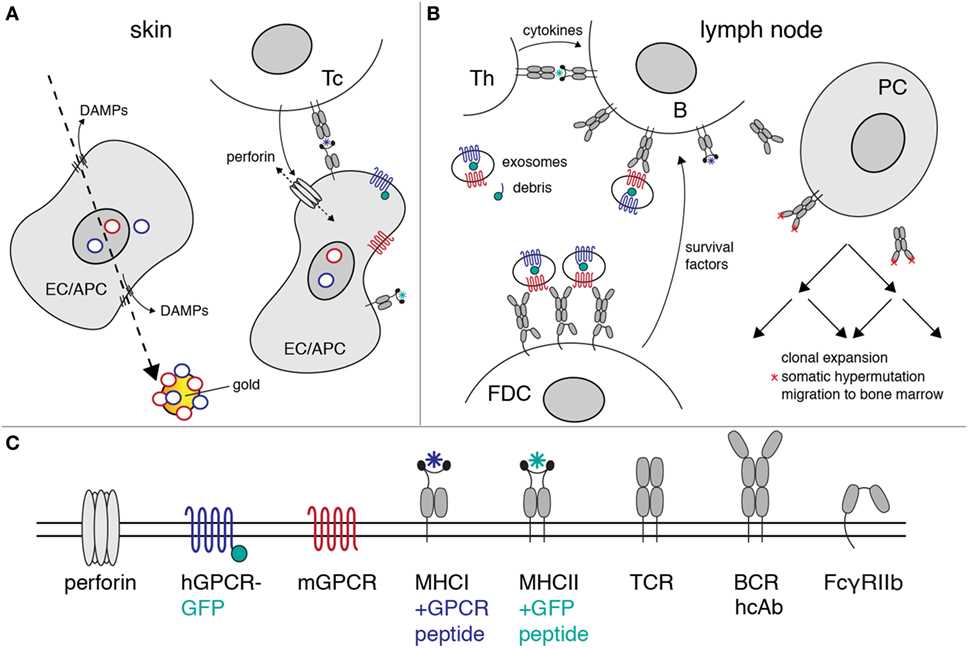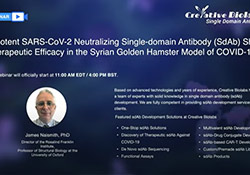Suitable Immunization Strategy Selection Service for Single Domain Antibody (SdAb) Discovery
Multiple Sites Immunization DNA Immunization Whole Cell Immunization Case Study Published Data FAQ Resources
As a pioneer and undisputed global leader in the field of VHH development, Creative Biolabs is proficient in applying advanced immunization strategies to satisfy various project demands. Based on our extensive experience, we have
earned a great reputation among our worldwide clients for successfully developing a series of high-quality VHHs against various challenging targets, such as small molecules, membrane proteins, and PTM-modified targets.
Depending on the target of interest and the specific project objective, our scientists can tailor the best-fit strategies to establish an appropriate immunization program. This program will involve one of the following typical strategies or combine some
of them as a heterologous strategy, which can contribute to triggering the best immune response.
Multiple Sites Immunization
Multiple sites immunization is the most standard strategy for large animal immunization. This strategy can elicit responses from several easily accessible sites, thereby contributing to the development of antibodies with high specificity and affinity.
It is also the best option if the injection of more than one antigen is required.
Typical Advantages of Multiple Sites Immunization
-
Triggers the desired immune response with a smaller amount of antigen
-
Allows the involvement of different antigens in a single immunization round
-
Compatible with various antigen formats

DNA Immunization
DNA immunization is an efficient approach to eliciting an immune response against challenging antigens. Compared with traditional immunization methods, DNA immunization allows for antigen production in vivo, thus avoiding the time-consuming
processes of antigen preparation. What's more, the naïve structure of the expressed antigens permits the generation of antibodies with high specificity and affinity.
Typical Advantages of DNA Immunization
-
Available for challenging antigens, such as insoluble proteins, multi-pass membrane proteins, secreted proteins, intracellular proteins, unstable proteins, etc.
-
Time- and labor-saving
-
Avoids the risk of antigen contamination
-
Generates antibodies with high affinity and specificity
Whole Cell Immunization
Whole cell immunization is a novel strategy to elicit an immune response against an antigen over-expressing cell line. Unlike conventional immunization strategies, whole cell immunization benefits from higher immunogenicity, naïve antigen structure, and
a simpler purification process. It is one of the best methods to discover novel VHHs against the extracellular domain of desired membrane protein targets.
Typical Advantages of Whole Cell Immunization
-
Allows the discovery of antibodies against the extracellular domain of membrane proteins
-
A powerful tool for identifying new biomarkers from surface proteins of tumor cell lines
-
Enables the generation of novel antibodies that recognize the naïve conformation of a target
With over a decade of extensive experience in providing immune-based VHH discovery projects, Creative Biolabs has contributed to discovering thousands of novel single domain antibodies for customers worldwide. If you are interested
in our services, please do not hesitate to contact us for more details.
Published Data
-
An Efficient Genetic Immunization Strategy for Generating VHHs
 Fig. 1 Proposed mechanism of heavy-chain antibody induction by genetic immunization.1
Fig. 1 Proposed mechanism of heavy-chain antibody induction by genetic immunization.1
 Fig. 2 CHO cells were transiently co-transfected with expression vectors to identify
specific binders.1
Fig. 2 CHO cells were transiently co-transfected with expression vectors to identify
specific binders.1
This article introduces an efficient genetic immunization strategy for generating VHHs against membrane proteins in their native conformation. As illustrated in Fig. 1, the study outlines a genetic immunization strategy that includes delivering cDNA plasmids
using gene gun technology, in vivo transcription of cDNA into mRNA, and subsequent translation into target membrane proteins, which induces B cells to produce specific VHHs. It has been demonstrated that this genetic immunization strategy
can effectively produce the desired membrane proteins in host cells and activate specific immune responses to produce high-affinity antibodies through a process of somatic hypermutation. Fig. 2 shows an effective high-throughput screening method that
uses VHH-based heavy chain antibodies for cell surface binding screening and detection with fluorescein-labeled secondary antibodies. This method can be utilized to identify VHHs targeting specific membrane proteins, thereby accelerating the discovery
and optimization of VHHs, which is crucial for developing novel diagnostic and therapeutic tools.
Reference
-
Eden, Thomas, et al. "A cDNA immunization strategy to generate single domain antibodies against membrane proteins in native conformation." Frontiers in immunology 8 (2018): 1989. Distributed under Open Access license CC BY 4.0, without modification.
FAQ
1. Q: What is the general immunization timeline?
In general, we perform the camel/llama/alpaca immunization with our standard 70-days strategy (for 4 injections), additional boost injections might be involved upon request. For the shark immunization, it usually takes a longish immune cycle (more than
4 months) to trigger an acceptable immune response.
2. Q: How many animals will be used for each project, any recommendation?
For the camel/llama/alpaca immunization, one animal can carrier most of the required tasks for research purpose. While for hit identification or challenging antigen, more than two animals are recommended. For the shark immunization, more than ten animals
are required for each project.
3. Q: What will happen if the animal died due to the toxic antigen?
The client is obliged to inform potential safety risk regarding the provided antigen. If undisclosed toxic antigen causes any damage to operators or experimental animals, the client shall be liable for all losses.
4. Q: Is that available to keep the host animal after immunization?
Yes. With advance notification, we can keep the animal after immunization until the clients’ further instruction. Corresponding maintenance fee will be charged monthly.
5. Q: What are the acceptable antigen types for immunization?
Till now, we can use a variety of antigen types for an immunization process, such as soluble protein/peptide, cell lines, DNA plasmid, and fusion protein.
6. Q: What is the least antigen quantity for an immunization procedure?
We usually need 1-2 mg antigen for the primary injection and 0.5-1 mg antigen for the subsequent injection. We have ever used 100-200 µg antigen for each injection and get an acceptable immune response for library construction. If the antigen is precious
or difficult to produce, we can reduce the used amount for each injection.
7. Q: What's the difference between camel, llama, and alpaca?
For therapeutic purposes, choosing alpacas and llamas as host animals may contribute more than camels, because of the less ratio of clones with additional disulfide bonds as well as higher homology with human.
For diagnostic purposes, camels should take more advantages considering the highest proportion of heavy-chain only antibody in sera IgG and also the highest percentage of containing additional disulfide bond within CDR1-CDR3 regions.
Please visit our
Host Animals page for more details.
8. Q: What is required for DNA immunization and whole cell immunization?
For DNA immunization, Creative Biolabs can start with either provided
in silico information or confirmed expression vector of the target of interest. Please note, we may also need purified protein format, target-overexpressing cell lines or epitope-mimic
peptides as screening targets.
For whole cell immunization, Creative Biolabs can offer cell line construction services or start from provided cell lines. Generally, two cell lines are required, one is overexpressing the target of interest and the other should be
from the same host strain but does not express the target.
Please visit our
Custom Antigen Design & Preparation Services page for more details.
9. Q: Deliverables of Immunization Stage
1. Project report including the titration results.
2. Pre-immune and test serum.
Resources
We are offering highly customized CRO services to assist your Single Domain Antibody (sdAb) related projects. Please Contact Us for more details.


 Fig. 1 Proposed mechanism of heavy-chain antibody induction by genetic immunization.1
Fig. 1 Proposed mechanism of heavy-chain antibody induction by genetic immunization.1
 Fig. 2 CHO cells were transiently co-transfected with expression vectors to identify
specific binders.1
Fig. 2 CHO cells were transiently co-transfected with expression vectors to identify
specific binders.1















